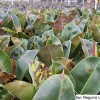 En verano del 2010, en viveros de Homestead se reportaron casos de Ficus elastica con manchas foliares circulares que se asemejan a los síntomas causados por la bacteria fitopatógena Xanthomonas campestris pv fici, aún no reportada en Ficus elastica. El daño severo affectó a la mayoría de los productores comerciales del sur de la Florida. This is the Spanish language version of Bacterial Blight of Ficus elastic Caused by Xanthomonas (PP305). This 3-page fact sheet was written by E. V. Campoverde, A. J. Palmateer, and P. Lopez, and published by the UF Department of Plant Pathology, July 2014.
En verano del 2010, en viveros de Homestead se reportaron casos de Ficus elastica con manchas foliares circulares que se asemejan a los síntomas causados por la bacteria fitopatógena Xanthomonas campestris pv fici, aún no reportada en Ficus elastica. El daño severo affectó a la mayoría de los productores comerciales del sur de la Florida. This is the Spanish language version of Bacterial Blight of Ficus elastic Caused by Xanthomonas (PP305). This 3-page fact sheet was written by E. V. Campoverde, A. J. Palmateer, and P. Lopez, and published by the UF Department of Plant Pathology, July 2014.
http://edis.ifas.ufl.edu/pp312
Tag: Ficus Pest Management
Ornamental Ficus Diseases: Identification and Control in Commercial Greenhouse Operations
 While edible figs are grown agronomically for delicious fruit, many Ficus species have been commercialized for decorative, ornamental purposes. These horticultural Ficus varieties are used for interiorscape houseplant décor and for outdoor landscape design. This article provides guidelines for the identification and treatment of diseases that may be encountered during the commercial production of ornamental Ficus. This 7-page fact sheet was written by D. J. Norman and Shad Ali, and published by the UF Department of Plant Pathology, August 2013.
While edible figs are grown agronomically for delicious fruit, many Ficus species have been commercialized for decorative, ornamental purposes. These horticultural Ficus varieties are used for interiorscape houseplant décor and for outdoor landscape design. This article provides guidelines for the identification and treatment of diseases that may be encountered during the commercial production of ornamental Ficus. This 7-page fact sheet was written by D. J. Norman and Shad Ali, and published by the UF Department of Plant Pathology, August 2013.
http://edis.ifas.ufl.edu/pp308
Bacterial Blight of Ficus elastica Caused by Xanthomonas (PP305)
 In the summer of 2010, leaf blight cases were reported on several Ficus elastica cultivars in Homestead nurseries. Symptoms somewhat resembled those caused by Xanthomonas campestris p.v. fici, but this pathogen has never been reported to occur on Ficus elastica. The outbreak was severe, and the majority of commercial producers in the southern portion of the state were affected. The widespread outbreak from 2010 to date has caused many nurseries to lose entire Ficus elastica crops. This 3-page fact sheet describes the symptoms and disease management recommendations. Written by E. V. Campoverde and A. J. Palmateer, and published by the UF Department of Plant Pathology, April 2013.
In the summer of 2010, leaf blight cases were reported on several Ficus elastica cultivars in Homestead nurseries. Symptoms somewhat resembled those caused by Xanthomonas campestris p.v. fici, but this pathogen has never been reported to occur on Ficus elastica. The outbreak was severe, and the majority of commercial producers in the southern portion of the state were affected. The widespread outbreak from 2010 to date has caused many nurseries to lose entire Ficus elastica crops. This 3-page fact sheet describes the symptoms and disease management recommendations. Written by E. V. Campoverde and A. J. Palmateer, and published by the UF Department of Plant Pathology, April 2013.
http://edis.ifas.ufl.edu/pp305